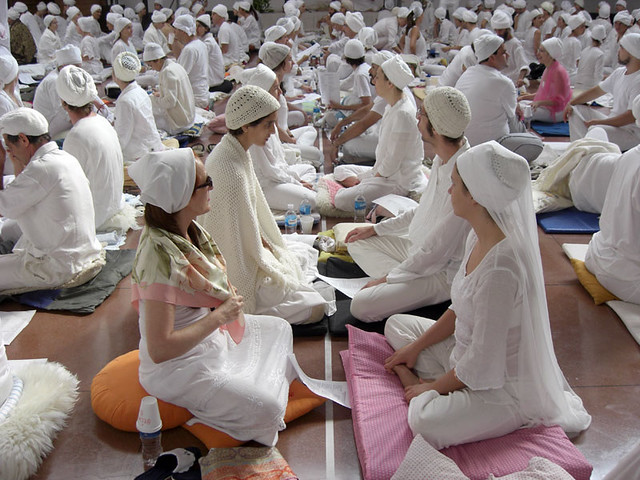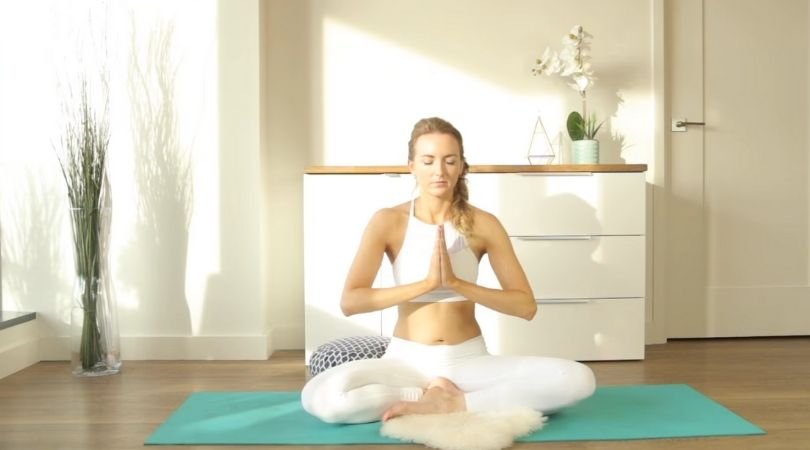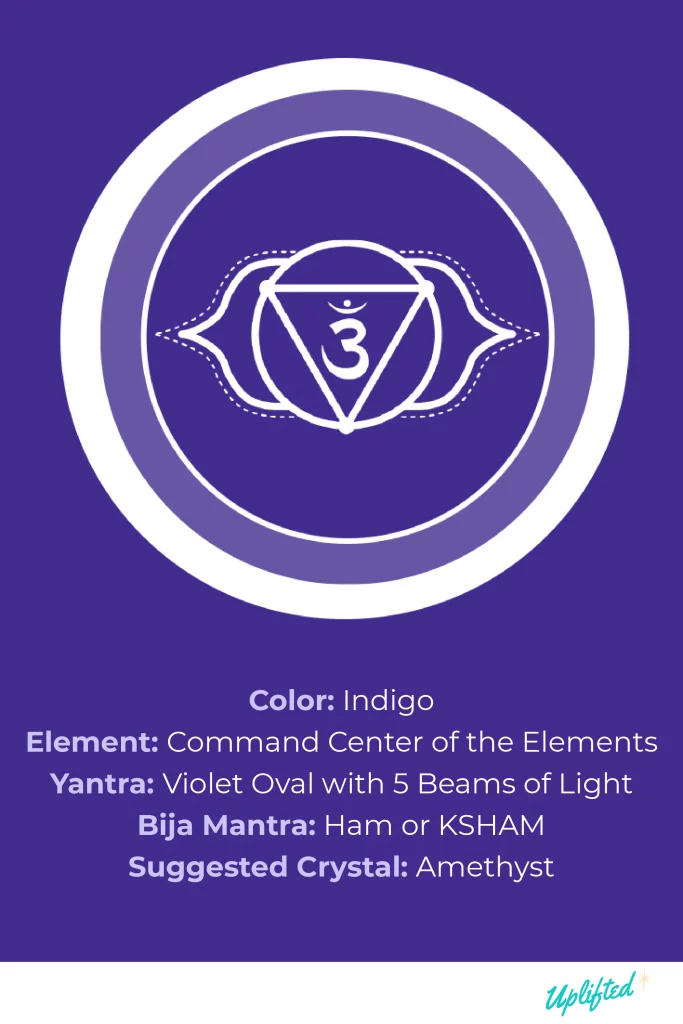Is it, like, ritual sex? 🚫 No.
Does it charge your energy?⚡ Absolutely.
So…what is White Tantra? Why is anything labeled as ‘Tantra’ stigmatized in certain yogic circles?
First, let’s define Tantra. Tantra means “to weave,” but in a historical and yogic context, scholars tend to define it as a “scripture” or “a tool for expansion” or “a system of practice.”
Tantra is a systematic, comprehensive, and practical system of spirituality that utilizes the whole human being (the breath, attention, imagination, body, etc.) to FREE the practitioner from ignorance and suffering. The majority of what I teach in my 300-hour Online Yoga Teacher Training is from tantric philosophy.
Now, what is White Tantra? Also called White Tantric Yoga® as trademarked by the 3HO organization? It’s a form of group meditation within the Tantric tradition, meaning you’re sitting together with many other yogis, all meditating at the same time, in certain configurations.
Not for the faint of heart, White Tantra is unlike any other Western yoga practice you’ve probably tried. Charged with rumor and temptation… intimidating to the uninitiated… White Tantra is often an ecstatic experience that is said to open the whole universe to its dedicated students.
When I practiced White Tantra, I looked for upcoming events for it in my area. I grabbed my water bottle, and Uber-ed over to the community center hosting the event. Many people come with a partner, but many don’t. I found a partner there. The practice consisted of close to 100 of us sitting cross legged on the floor, doing Kundalini yoga as taught by Yogi Bhajan (to his voice and videos) for a full day. There was a break for lunch. It was mandatory to wear white and a head covering.
Whether you’re interested in trying White Tantra like I did, or just want to know the truth about this mysterious form of yoga, here’s everything you need to know.
1. White Tantra is about sex.
In the Western world, we’ve been led to believe that all Tantra is centered on sexual energy and the sexual act. Though this isn’t really true (White Tantra is clothes ON), Tantric philosophy is bound to the exploration of union – spiritual, emotional, and yes – sexual. The origins of Tantra are believed to date back to the sixth or seventh century A.D., though other scholars affirm its origins further back to the pre-Aryan period.
The word “Tantra” has many meanings, each with its own nuance that depends on the context in which it’s used. The most common definition of tantra is an instrument to expand the level of consciousness. Tantra differs from other, more subdued versions of Eastern spirituality in that it embraces the physical world rather than withdrawing from it. The philosophy of Tantra can be summed up as: “nothing exists that isn’t divine.” In this sense everything, including sexual practice is seen as a divine means for spiritual growth.
Though White Tantra does not include explicit sexual energy or practices, it does enhance the connection between the physical realm and your inner world.
2. There are many different shades of Tantric Yoga!
If you’re most familiar with Tantra in reference to Tantric sex and physical intimacy, you aren’t alone. There are actually multiple types of Tantric Yoga, and not all of them involve the sexual act. In fact, Hatha yoga is actually derived from Tantra, though it branched off prior to the “shades of Tantra” described below.
There are five main types of Tantra practiced today:
- White Tantra: White Tantra is often used to describe the purely spiritual path of Tantra. This often utilizes meditation, breath work, sounds, and postures.
- Red Tantra: Red tantra is focused on the divine union of sex. It focuses on the dual energies of male and female, and how the two unite to form complete divinity.
- Pink Tantra: This is often seen as the middle ground between White and Red Tantra. It’s a mix of individual and partner-based practices.
- Black Tantra: Black Tantra is sometimes likened to “black magic.” It utilizes certain magical capabilities (siddhis) in order to manifest things in the physical world.
- Gray Tantra: Gray Tantra also utilizes certain magical powers (siddhis) but instead of creating material abundance, it is focused on spiritual development.
3. White Tantra is a must for anyone interested in uplifting their consciousness.
According to Kundalini yogis, the practice of White Tantric Yoga is a sure-fire way to release deep subconscious blockages. It’s said that the effects of a one day practice will ripple into your life for a long time. For those interested in the subtle body energetics that Kundalini yoga focuses on, White Tantra is a wonderful practice to expand self awareness.
Are You Chanting Correctly? Refine Your Tune with Me! 👇

Are You Chanting Correctly? Refine Your Tune with Me!

4. Traditionally, White Tantric Yoga is a group meditation guided by an experienced teacher.
Don’t try this at home, yogis 😉. Though there are many yoga rituals you can introduce to your solo practice at home, White Tantric Yoga isn’t one of them. First off, because you need a partner. Secondly, because it works with the energy of a group (the bigger the better). Yes: White Tantra is practiced in large groups. Yogis gather, sometimes by the hundreds, to take part in this meditative practice together. It’s said that working with group consciousness creates a deeper bond both with your fellow yogis and with your Inner Self. Some reputable teachers claim that the more yogis gather, the more effective the practice is on the individual level.
5. Yogi Bhajan developed and publicized the practice of White Tantric Yoga in the West.
Like most sacred practices of the East, White Tantric Yoga was passed down from teacher to student in a selective and mystical way. In 1970, the practice was officially opened to the public and anyone willing to commit to this deep dive into spiritual purification.
The controversial father of Kundalini yoga, Yogi Bhajan, led White Tantric Yoga workshops until 1986. After his death, these events continued, led virtually through a series of video tapes he created through the KRI and 3HO organizations. Though you can find modern White Tantra events led by live teachers, the videos from Yogi Bhajan are still used to this day by KRI.
6. White Tantric Yoga was originally taught by a lineage of spiritual teachers known as the Mahan Tantrics.
Though his name has long-survived his death, Yogi Bhajan was merely one of the masters in a long lineage of teachers known as the Mahan Tantrics. While documentation of the Mahan Tantra lineage is impossible to confirm (no known records were kept), we do know that the practice of White Tantra has greatly evolved during the 30 years since Yogi Bhajan first introduced it to Western practitioners. From the first course he ever taught, to the video courses that are in service today, and even beyond into the future, the practice of White Tantra is consciousness evolution in action.
7. It’s kind of like a staring contest without a winner.
So, what are the specific methods of White Tantra? During these day-long, guided, immersive rituals, practitioners take part in various meditative exercises, chants and postures with their meditation partners. Most notably, this form of Tantra Yoga includes gazing into the eyes of your partner for multiple 31-minute or 62-minute meditations, with half-hour breaks in between. For anyone who’s experienced an eye-gazing meditation before, you can probably imagine how intense this can be! Some report Kundalini awakening during the meditation, others can’t suppress the giggles, and still others experience a flood of emotion.
Take my quiz to learn if YOUR kundalini energy is awakened 👇
8. Expect the unexpected.
Though looking into someone’s eyes might sound simple enough, doing it for a prolonged period of time often brings unexpected reactions. Many students report deep emotional sensations, tears, giggles, resurfaced memories, and other impactful experiences. Truth be told, you probably have no idea how you will react until you try it for yourself. So, if you are interested, be sure to go in with an open mind and expect the unexpected.
9. Practitioners traditionally wear white and cover their heads.
This is a proverbial tradition in Kundalini Yoga. By wearing stark shades of white, you’re expressing your deep reverence and gratitude for the Kundalini Energy. Philosophically, wearing white is said to expand your electromagnetic field. With this strengthened field, we can better ground our physical body, protect ourselves from negativity, and elevate energy into our radiant body.
By covering your head and wearing a headwrap, it’s believed that you’re containing the energy of your crown chakra and strengthening your spiritual power. I go over this in more detail and other kundalini yoga traditions in my Kundalini Demystified course.
10. Your third eye chakra will thank you.
While practicing White Tantric Yoga, we move away from the limitations of the human mind and into the full power of the Ajna Chakra, or third eye. Like we just mentioned, the practice of White Tantra is meant to contain and supercharge the energy your upper chakras create during meditation. If we are able to harness these energies, they can eventually guide us towards enlightenment.
11. 3HO and KRI-affiliated teachers continue to offer White Tantric practices guided on video by Yogi Bhajan around the world.
Though Yogi Bhajan is no longer with us, modern Kundalini institutions will still honor the guru by sharing his video recordings during these day-long White Tantra sessions. If you attend a KRI or 3HO-affiliated event, expect Yogi Bhajan to address you from the grave via recorded address between your meditations. The intention is to preserve and honor the tradition’s heritage, but if you’d rather not meditate with a sexual predator – you can find independently led White Tantric events around the world.
12. Everything will gel in the 40 days after your White Tantric practice.
If you feel underwhelmed after your day-long immersion, give it some time. Many people report nights of intensely deep sleep and recurring mental breakthroughs following a White Tantric gathering. Just keep in mind that the effects of White Tantra can take up to 40 days to present themselves.
13. Train yourself to sit all day before you go.
Traditional White Tantra classes involve long bouts (31 – 61 minutes) of seated meditation. If you’re not used to sitting unassisted for this period of time, this practice could wreak havoc on your body. If you’re really interested in trying a White Tantric immersion, we recommend practicing consistent, seated meditation for a few weeks before you go. It might also be beneficial to do a bit of light stretching before the big day. Here’s a fun fact: traditionally, yoga asana had the sole purpose of preparing the body for long bouts of seated meditation – so practicing yoga asana is a great way to prepare as well!
14. Make it a date – or just bring yourself and an open mind.
White Tantra meditations are done in pairs, and you and your partner will sit facing one another in a long line of fellow meditators. While there are also times for mantra and relaxation throughout the day, most of the meditations involved locking eye-to-eye with the person sitting across from you. It’s not necessary that you come ready to go with a partner, though it could make the experience more comfortable for you. Maybe like a 3rd date activity? Those who arrive solo will be partnered up with someone. Kundalini and Tantra yogis claim that you’ll be intuitively guided to the best partner for you for the day, guaranteed.
15. It’s all about that “Z” energy.

As is so with traditional Tantra, nothing is accidental in a White Tantra meditation. The seating arrangement is completely intentional. The long lines of pairs cultivate a certain “Z” energy. This “Z energy” is in reference to the alchemy of polarities that exist in a traditional White Tantra gathering. During a White Tantra meditation session, pairs are lined up neatly in straight lines. This is meant to harness a strong diagonal energy that is designed to cut directly through blocks in our collective subconscious. These diagonals create the “Z” energy. This energy creates movement within each student’s electro-magnetic field and is then amplified amongst the columns and rows in which they are geometrically seated. Pretty nifty, huh?
16. …Like plugging into the motherboard of human energy.
Thanks to “Z energy,” the collective movement of energy in a White Tantric Yoga event can be compared to the electric current running through a motherboard. Through this human motherboard, you are able to transcend your physical body and connect to the subtle energy with that of your partner and the other participants. This dynamic strengthens the group vibration and allows you to work deeply into your subconscious mind, releasing trauma and revealing subconscious wisdom. Tantra refers to this group energy as a “weave” that casts its net deep into your subconscious mind. This is what allows the White Tantric magic to happen.
17. Bring something comfy to sit on.
If you do choose to attend a day-long meditation, be aware that you will be sitting on the floor all day long. It would be wise to bring along a meditation cushion, a yoga block or two, and maybe a blanket to sit up on. See point #13 for more on preparing your body for the challenge. A yoga mat never hurt either! 😊
18. The effects of a White Tantric practice are said to equal a full year of individual meditation practice.
Collective rituals like White Tantra are said to have an intense pay off. If you’re really hoping to deepen your awareness and path to healing, know that one day of practicing White Tantric Yoga is said to equal one full year of personal meditation practice. While yoga isn’t ever about shortcuts, it’s worth a try to feel the effects for yourself!
19. The goal is conquering the mind.
Beyond the physical challenges that come with a full day of seated meditation, the biggest opportunity for healing through White Tantra rests in the mind. As with all meditation, the immediate benefits of learning to quiet thoughts and focus the mind are direct side-effects of this practice. Additionally, there are also innate teachings of unity that come with White Tantra. Kriyas (or yogic cleansing practices) like eye gazing are becoming increasingly popular and for good reason.
Eye gazing allows you to connect with both your inner and outer experiences. It works to break down barriers between you and others. Eventually, this grants you the power to experience oneness with the infinite and with everyone around you.
20. Intrigued by the energetics of polarity? Learn more about it in my KU YTT.
Though Kundalini and Tantra are deeply steeped in tradition, today we have the opportunity to elevate our yoga practice and co-create a new path forward. As you know I have a full video on polarity in my Kundalini Demystified course. However, if you’re interested in learning more about the energetics of polarity and Tantra, join Guru Singh and I in our Kundalini University Yoga Teacher Training. We teach yogis just like you to demystify Tantra, polarity, and discover the joys of the Kundalini path through modern teachings you can do anywhere. Don’t forget there is also the polarity play kriya in my Uplifted membership that you can do within 40 day kriya plan also!
21. With the passing of Yogi Bhajan, White Tantric Yoga is open for truly conscious exploration.
White Tantra is an ecstatic experience that has been practiced in a variety of forms since yoga emerged. While some traditionalists say it is only meant to be practiced under the direct influence of a Mahan Tantric Yoga Master (aka Yogi Bhajan), modernists challenge these restrictions along with the very hierarchy of spiritual lineages that have sheltered leaders from accountability and enabled abuse. Now is the time to reclaim this beautiful practice and open it for deeper exploration and interpretation. Learn more about Tantra and how to rise to your highest divine consciousness in my Kundalini Yoga Teacher Training!
Next Steps
- Love Kundalini? Refine your tune in (the Adi Mantra) with me in this free chanting masterclass.
- Experience my Kundalini Dance Party and elevate your mood in 8 minutes.
- Enroll in my Kundalini Demystified training course. Let’s demystify the “mystery” of this ancient science and INSTANTLY reap the benefits!
Get 3 Free Training Vidoes from our Kundalini University Experience & Certification Program

YOU MIGHT ALSO LIKE
- Trauma-Informed Kundalini Yoga: A Heart-Centered Approach to Healing
- Harnessing the Power of Kundalini Divine Feminine for Transformation
- Kundalini for Feminine Energy: Ignite Your Creative Power and Passion
- Mastering the Sufi Grind: Benefits and Techniques for All Levels
- Kundalini Yoga for Chakras: An Uplifted Guide to Energy Balance
- Discover the Benefits of the Gobinday Mukunday Mantra for Well-Being
- Nabhi Kriya: Ignite Your Inner Fire and Personal Power
- Ek Ong Kar Sat Gur Prasad: Kundalini Mantra For Manifestation
- Tantric Har Chant: How It Fuels Prosperity and Inner Power
- Powerful Mantra for Protection Against Negative Energy and Harm
- The Power of Humee Hum Brahm Hum Mantra for Connection and Healing
- The Sa Re Sa Sa Mantra: Connecting Breath, Light, and Creativity
- What Is The Ajai Alai Mantra In Kundalini Yoga?
- What Is Sat Nam Rasayan? How And When To Practice
- The Meaning Of Ang Sang Wahe Guru Mantra in Kundalini Yoga
Learn how to do 11 of the most popular yoga poses correctly. Free video + PDF download.
















